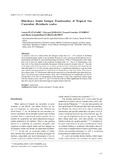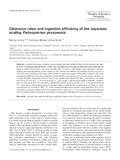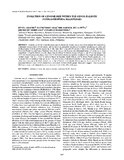Pencarian
Now showing items 1-10 of 207
Diet-tissue stable isotopic fractionation of tropical sea cucumber, Holothuria scabra
(Japan International Research Center for Agricultural Sciences (JIRCAS), 2013)
To provide a basis for a stable carbon and nitrogen isotope ratio \(\mathsf{(\delta^{13}C / \delta^{15}N)}\) analysis to determine the assimilated organic matter in sea cucumber, Holothuria scabra, diet-tissue fractionations ...
The sea cucumber fishery in Palawan, Philippines
(高知大学大学院黒潮圏海洋科学研究科, 2018)
This paper presents the nature of sea cucumber fishery in Palawan, Philippines with information on gathering practices, commonly traded species and secondary accounts on wild populations. Current issues on sea cucumber ...
Reproductive development of the threatened giant grouper Epinephelus lanceolatus
(Elsevier, 2019-05-02)
The giant grouper is presumed to follow the reproductive pattern of most Epinephelus species, characterized by protogynous hermaphroditism wherein male maturation is attained through sex reversal of a functional female. ...
Fish performance, nutrient digestibilities, and hepatic and intestinal morphologies in grouper Epinephelus fuscoguttatus fed fermented copra meal
(Elsevier, 2019-07)
Protein enhanced copra meal (PECM®) is an alternative, cheap, and sustainable source of plant protein for the aquafeed industry, albeit its use on carnivorous fish species has been very limited. A 70-day feeding trial using ...
Quantitative and qualitative analyses of the bacterial microbiota of tilapia (Oreochromis niloticus) cultured in earthen ponds in the Philippines
(Springer Verlag, 2015)
The quantity and composition of the bacterial microbiota in the rearing water, sediment, gills and intestines of tilapia Oreochromis niloticus collected every 2 weeks from Day 30 to Day 120 after stocking for grow-out ...
Feeding selectivity of the seahorse, Hippocampus kuda (Bleeker), juveniles under laboratory conditions
(Blackwell Publishing Ltd, 2012)
This study examined the feeding selectivity of Hippocampus kuda juveniles under captive conditions and evaluates different food organisms that could be used to improve hatchery-rearing of this species. Newly born H. kuda ...
Draft genome sequence of Vibrio parahaemolyticus strain PH1339, which causes acute hepatopancreatic necrosis disease in shrimp in the Philippines
(American Society for Microbiology, 2019-11-14)
We report the first draft genome sequence of an acute hepatopancreatic necrosis disease (AHPND)-causing Vibrio parahaemolyticus strain isolated from a Penaeus vannamei sample from the Philippines. The strain carries the ...
Clearance rates and ingestion efficiency of the Japanese scallop Patinopecten yessoensis
(Plankton Society of Japan, 2013)
In coastal ecosystems, variations in food quantity may have significant effects on the clearance and ingestion rates of suspension-feeding bivalves. In this study, clearance rates and ingestion efficiencies were determined ...
Evolution of genome size within the genus Haliotis (Vetigastropoda: Haliotidae)
(National Shellfisheries Association, 2018)
Genome size (C-value) and the percentage of adenine and thymine nucleotides in the genome (AT content) are fundamental characteristics of every species, and very important parameters in molecular cytogenetic and phylogenic ...
Draft genome sequence of multidrug-resistant Vibrio parahaemolyticus strain PH698, infecting penaeid shrimp in the Philippines
(American Society for Microbiology, 2019-11-21)
The emergence of multidrug-resistant bacterial strains in diverse settings has been reported globally. In the Philippine shrimp aquaculture industry, antibiotics are used for the treatment of bacterial diseases during the ...











